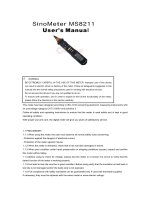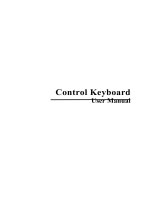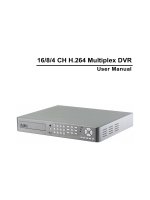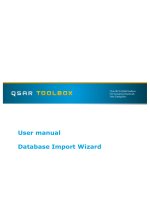PSIM user manual (powersim technologies inc )
Bạn đang xem bản rút gọn của tài liệu. Xem và tải ngay bản đầy đủ của tài liệu tại đây (1.22 MB, 126 trang )
PSIM
User Manual
Powersim Technologies Inc.
PSIM User Manual
PSIM Version 4.0
January 1999
Copyright 1996-1999 Powersim Technologies Inc.
All rights reserved. No part of this manual may be photocopied or reproduced in any form or by any means without
the written permission of Powersim Technologies Inc.
Disclaimer
Powersim Technologies Inc. (“Powersim”) makes no representation or warranty with respect to the adequacy or accu-
racy of this documentation or the software which it describes. In no event will Powersim or its direct or indirect sup-
pliers be liable for any damages whatsoever including, but not limited to, direct, indirect, incidental, or consequential
damages of any character including, without limitation, loss of business profits, data, business information, or any
and all other commercial damages or losses, or for any damages in excess of the list price for the licence to the soft-
ware and documentation.
Powersim Technologies Inc.
#10 - 7120 Gilbert Rd.
Richmond, B.C.
Canada V7C 5G7
Tel: (604) 214-1364
Fax: (604) 214-1365
email:
PSIM User Manual
i
Table of Contents
Chapter 1 General Information
1.1 Introduction 1-1
1.2 Circuit Structure 1-1
1.3 Software/Hardware Requirement 1-2
1.4 Installing the Program 1-2
1.5 Simulating a Circuit 1-3
Chapter 2 Power Circuit Components
2.1 Resistor-Inductor-Capacitor Branches (RLC) 2-1
2.2 Switches 2-2
2.2.1 Diodes and Zener Diodes (DIODE/ZENER) 2-2
2.2.2 Thyristors (THY) 2-3
2.2.3 GTO, Transistors, and Bi-Directional Switches 2-4
2.2.4 Switch Gating Blocks (GATING) 2-5
2.2.5 Single-Phase Switch Modules 2-6
2.2.6 Three-Phase Switch Modules 2-7
2.3 Coupled Inductors (MUT2/MUT3) 2-8
2.4 Transformers 2-10
2.4.1 Ideal Transformers (TF_IDEAL) 2-10
2.4.2 Single-Phase Transformers 2-10
2.4.3 Three-Phase Transformers 2-12
2.5 Motor Drive Module 2-14
2.5.1 Electric Machines 2-14
2.5.1.1 DC Machine (DCM) 2-14
2.5.1.2 Induction Machine (INDM_3S/INDM_3SN) 2-17
2.5.1.3 Switched Reluctance Machine (SRM3) 2-20
2.5.2 Mechanical Loads 2-23
2.5.2.1 Constant-Torque Load (MLOAD_T) 2-23
2.5.2.2 Constant-Power Load (MLOAD_P) 2-24
ii
PSIM User Manual
2.5.2.3 General-Type Load (MLOAD) 2-25
Chapter 3 Control Circuit Component
3.1 Transfer Function Blocks (TFCTN) 3-1
3.1.1 Proportional Controllers (P) 3-1
3.1.2 Integrators (INT/RESETI) 3-2
3.1.3 Differentiators (DIFF) 3-3
3.1.4 Proportional-Integral Controllers (PI) 3-4
3.1.5 Built-in Filter Blocks 3-4
3.2 Computational Function Blocks 3-5
3.2.1 Summers (SUM) 3-5
3.2.2 Multipliers and Dividers (MULT/DIVD) 3-6
3.2.3 Square-Root Blocks (SQROT) 3-7
3.2.4 Exponential/Power Function Blocks (EXP/POWER) 3-7
3.2.5 Root-Mean-Square Blocks (RMS) 3-7
3.2.6 Absolute Value Function Blocks (ABS) 3-8
3.2.7 Trigonometric Functions (SIN/COS/COS_1/TG_1) 3-8
3.2.8 Fast Fourier Transform Blocks (FFT) 3-9
3.3 Other Function Blocks 3-10
3.3.1 Comparators (COMP) 3-10
3.3.2 Limiters (LIM) 3-10
3.3.3 Look-up Tables (LKUP/LKUP2D) 3-11
3.3.4 Sampling/Hold Blocks (SAMP) 3-12
3.3.5 Round-Off Blocks (ROUNDOFF) 3-13
3.3.6 Time Delay Blocks (TDELAY) 3-14
3.3.7 Multiplexers (MUX2/MUX4/MUX8) 3-15
3.4 Subcircuit Blocks 3-16
3.4.1 Operational Amplifiers (OP_AMP) 3-16
3.4.2 THD Blocks (THD) 3-17
3.5 Logic Components 3-19
3.5.1 Logic Gates 3-19
3.5.2 Set-Reset Flip-Flops (SRFF) 3-19
3.5.3 J-K Flip-Flops (JKFF) 3-20
3.5.4 Monostable Multivibrators (MONO/MONOC) 3-20
3.5.5 Pulse Width Counters (PWCT) 3-21
PSIM User Manual
iii
3.6 Digital Control Module 3-21
3.6.1 Zero-Order Hold 3-21
3.6.2 z-Domain Transfer Function Block 3-22
3.6.2.1 Integrators 3-23
3.6.2.2 Differentiators 3-25
3.6.2.3 Digital Filters 3-25
3.6.3 Unit Delay 3-28
3.6.4 Quantization Block 3-28
3.6.5 Circular Buffer 3-30
3.6.6 Convolution Block 3-30
3.6.7 Memory Read Block 3-31
3.6.8 Data Array 3-32
3.6.9 Multi-Rate Sampling System 3-32
Chapter 4 Other Components
4.1 Simulation Control 4-1
4.2 Time 4-2
4.3 Independent Voltage/Current Sources 4-2
4.3.1 DC Sources (VDC/IDC/VDC_GND) 4-2
4.3.2 Sinusoidal Sources (VSIN/VSIN3/ISIN) 4-2
4.3.3 Square-Wave Sources (VSQU/ISQU) 4-4
4.3.4 Triangular Sources (VTRI/ITRI) 4-4
4.3.5 Step Sources (VSTEP/ISTEP) 4-5
4.3.6 Piecewise Linear Sources (VGNL/IGNL) 4-6
4.3.7 Random Sources (VRAND/IRAND) 4-7
4.4 Voltage/Current-Controlled Sources 4-7
4.5 Nonlinear Voltage-Controlled Sources 4-8
4.6 Voltage/Current Sensors (VSEN/ISEN) 4-9
4.7 Speed/Torque Sensors (WSEN/TSEN) 4-10
4.8 Probes and Meters 4-11
4.9 Switch Controllers 4-12
4.9.1 On-Off Switch Controllers (ONCTRL) 4-12
iv
PSIM User Manual
4.9.2 Alpha Controllers (ACTRL) 4-13
4.9.3 PWM Lookup Table Controllers (PATTCTRL) 4- 14
4.10 Control-Power Interface Blocks (CTOP) 4-16
4.11 ABC-DQO Transformation Blocks (ABC2DQO/DQO2ABC) 4-17
4.12 External DLL Blocks 4-19
4.13 Simulated Frequency Response Analyzers (SFRA) 4-22
Chapter 5 Circuit Schematic Design Using SIMCAD
5.1 Creating a Circuit 5-2
5.2 Editing a Circuit 5-3
5.3 Subcircuits 5-3
5.3.1 Creating Subcircuit - In the Main Circuit 5-4
5.3.2 Creating Subcircuit - Inside the Subcircuit 5-4
5.4 Other Options 5-6
5.4.1 Simulation Control 5-6
5.4.2 Running the Simulation 5-6
5.4.3 Settings Settings 5-6
5.4.4 Printing the Circuit Schematic 5-7
5.5 Editing SIMCAD Library 5-7
5.5.1 Editing an Element 5-7
5.5.2 Creating a New Element 5-7
5.5.3 Ground Element 5-8
Chapter 6 Waveform Processing Using SIMVIEW
6.1 File Menu 6-2
6.2 Edit Menu 6-2
6.3 Axis Menu 6-3
6.4 Screen Menu 6-4
6.5 View Menu 6-5
6.6 Option Menu 6-6
PSIM User Manual
v
6.7 Label Menu 6-7
6.8 Exporting Data 6-8
Chapter 7 Error/Warning Messages and General Simulation Issues
7.1 Simulation Issues 7-1
7.1.1 Time Step Selection 7-1
7.1.2 Propagation Delays in Logic Circuits 7-1
7.1.3 Interface Between Power and Control Circuits 7-1
7.1.4 FFT Analysis 7-2
7.2 Error/Warning Messages 7-2
7.3 Debugging 7-4
Appendix A: Examples
A-1
Appendix B: List of Elements
B-1
vi
PSIM User Manual
Introduction
PSIM User Manual
1-1
Chapter 1: General Information
1.1 Introduction
This manual covers both PSIM
*
and its add-on Motor Drive Module and Digital Control
Module. Functions and features for these two modules are marked wherever they occur.
The Motor Drive Module has built-in machine models and mechanical load models for
drive system studies. The Digital Control Module, on the other hand, provides discrete
elements such as zero-order hold, z-domain transfer function blocks, quantization blocks,
for digital control analysis.
PSIM is a simulation package specifically designed for power electronics and motor con-
trol. With fast simulation, friendly user interface and waveform processing, PSIM pro-
vides a powerful simulation environment for power converter analysis, control loop
design, and motor drive system studies.
The PSIM simulation package consists of three programs: circuit schematic editor SIM-
CAD
*
, PSIM simulator, and waveform processing program SIMVIEW
*
. The simulation
environment is illustrated as follows.
Chapter 1 of this manual describes the circuit structure, software/hardware requirement,
and installation procedure. Chapter 2 through 4 describe the power and control circuit
components. The use of SIMCAD and SIMVIEW is discussed in Chapter 5 and 6. Error/
warning messages are listed in Chapter 7. Finally, sample examples are provided in
Appendix A, and a list of the PSIM elements is given in Appendix B.
1.2 Circuit Structure
A circuit is represented in PSIM in four blocks: power circuit, control circuit, sensors, and
switch controllers. The figure below shows the relationship between each block.
*. PSIM, SIMCAD, and SIMVIEW are copyright by Powersim Technologies Inc., 1996-1999
PSIM
SIMCAD
SIMVIEW
Circuit Schematic Editor (output: *.sch)
PSIM Simulator (input: *.cct; output: *.txt)
Waveform Processor (input: *.txt)
Chapter 1: General Information
1-2
PSIM User Manual
The power circuit consists of switching devices, RLC branches, transformers, and other
discrete components. The control circuit is represented in block diagram. Components in s
domain and z domain, logic components (such as logic gates and flip flops), and nonlinear
components (such as multipliers and dividers) can be used in the control circuit. Sensors
measure power circuit voltages and currents and pass the values to the control circuit. Gat-
ing signals are then generated from the control circuit and sent back to the power circuit
through switch controllers to control switches.
1.3 Software/Hardware Requirement
PSIM runs in Microsoft Windows 95 or NT on PC computers. The RAM memory require-
ment is 16 MB.
1.4 Installing the Program
A quick installation guide is provided in the flier “PSIM - Quick Guide”.
Some of the files in the PSIM directory are:
Files Description
psim.exe PSIM simulator
simcad.exe Circuit schematic editor SIMCAD
simview.exe Waveform processor SIMVIEW
simcad.lib PSIM component library
*.hlp Help files
*.sch Sample schematic circuit files
Power Circuit
Control Circuit
Sensors
Switch
Controllers
Simulating a Circuit
PSIM User Manual
1-3
File extensions used in PSIM are:
1.5 Simulating a Circuit
To simulate the sample one-quadrant chopper circuit “chop.sch”:
- Start SIMCAD. Choose
Open
from the
File
menu to load the file “chop.sch”.
- From the
Simulate
menu, choose
Run PSIM
. A netlist file, “chop.cct”, will be
generated. PSIM simulator will read the netlist file and start simulation. The
simulation results will be saved to File “chop.txt”. Any warning messages
occurred in the simulation will be saved to File “message.doc”.
- From the
Simulate
menu, choose
Run SIMVIEW
to start SIMVIEW, and select
curves for display.
*.sch SIMCAD schematic file (binary)
*.cct PSIM circuit file (text)
*.txt PSIM simulation output file (text)
*.smv SIMVIEW waveform file (binary)
Chapter 1: General Information
1-4
PSIM User Manual
Resistor-Inductor-Capacitor Branches
PSIM User Manual
2-1
Chapter 2: Power Circuit Components
2.1 Resistor-Inductor-Capacitor Branches
Both individual resistor, inductor, capacitor branches and lumped RLC branches are pro-
vided in PSIM. Inductor currents and capacitor voltages can be set as initial conditions.
To facilitate the setup of three-phase circuits, symmetrical three-phase RLC branches,
“R3”, “RL3”, “RC3”, “RLC3”, are provided. The initial inductor currents and capacitor
voltages of the three-phase branches are all set to zero.
Images:
For the three-phase branches, the phase with a dot is Phase A.
Attributes:
The resistance, inductance, or capacitance of a branch can not be all zero. At least one of
the parameters has to be a non-zero value.
Parameters Description
Resistance Resistance, in Ohm
Inductance Inductance, in H
Capacitance Capacitance, in F
Initial Current Initial inductor current, in A
Initial Cap. Voltage Initial capacitor voltage, in V
Current Flag Flag for branch current output. When the flag is zero, there
is no current output. If the flag is 1, the current will be saved
to the output file for display. The current is positive when it
flows into the dotted terminal of the branch.
Current Flag_A;
Current Flag_B;
Current Flag_C
Flags for Phase A, B, and C of the three-phase branches,
respectively.
RL
C
RL RC
R3 RL3 RC3 RLC3
RLC
LC
Chapter 2: Power Circuit Component
2-2
PSIM User Manual
2.2 Switches
There are four basic types of switches in PSIM:
Diodes (DIODE)
Thyristors (THY)
Self-commutated switches (GTO, IGBT, MOSFET)
Bi-directional switches (SSWI)
Switch models are ideal. That is, both turn-on and turn-off transients are neglected. A
switch has an on-resistance of 10
µΩ
and an off-resistance of 1M
Ω
. Snubber circuits are
not required for switches.
2.2.1 Diodes and Zener Diodes
The conduction of a diode is determined by the circuit operating condition. The diode is
turned on when it is positively biased, and is turned off when the current drops to zero.
Image:
Attributes:
A zener diode in PSIM is modelled by a circuit as shown below.
Image:
Parameters Description
Initial Position Flag for the initial diode position. If the flag is 0, the diode is
open. If it is 1, the diode is closed.
Current Flag Flags for the diode current printout. If the flag is 0, there is
no current output. If the flag is 1, the diode current will be
saved to the output file for display.
DIODE
ZENER
Circuit Model
A
K
A
K
V
B
Switches
PSIM User Manual
2-3
Attributes:
If the zener diode is positively biased, it behaviors as a regular diode. When it is reverse
biased, it will block the conduction as long as the cathode-anode voltage V
KA
is less than
the breakdown voltage V
B
. Otherwise, the voltage V
KA
will be clamped to V
B
.
2.2.2 Thyristors
A thyristor is controlled at turn-on. The turn-off is determined by the circuit conditions.
Image:
Attributes:
There are two ways to control a thyristor. One way is to use a gating block (GATING).
Another is to use a switch controller. Both of them must be connected to the gate node of
the thyristor.
The following examples illustrate the control of a thyristor switch.
Examples: Control of a Thyristor Switch
Parameters Description
Breakdown Voltage Breakdown voltage V
B
of the zener diode, in V
Parameters Description
Initial Position Flag for the initial switch position
Current Flag Flag for switch current output
THY
AK
Gate
Gating Block
Alpha Controller
Chapter 2: Power Circuit Component
2-4
PSIM User Manual
This circuit on the left uses a switching gating block (see Section 2.2.4). The switching
gating pattern and the frequency are pre-defined, and will remain unchanged throughout
the simulation. The circuit on the right uses an alpha controller (see Section 4.7.2). The
delay angle alpha, in degree, is specified through the dc source in the circuit.
2.2.3 GTO, Transistors, and Bi-Directional Switches
A self-commutated switch, such as GTO, IGBT, and MOSFET, is turned on when the gat-
ing is high and the switch is positively biased. It is turned off whenever the gating is low
or the current drops to zero. A GTO switch is a symmetrical device with both forward-
blocking and reverse-blocking capabilities. An IGBT or MOSFET switch consist of an
active switch with an anti-parallel diode.
A bi-directional switch (SSWI) conducts currents in both directions. It is on when the gat-
ing is high and is off when the gating is low, regardless of the voltage bias conditions of
the switch.
Images:
Attributes:
A self-commutated switch can be controlled by either a gating block (GATING) or a
switch controller. They must be connected to the gate (base) node of the switch The fol-
lowing examples illustrate the control of a MOSFET switch.
Examples: Control of a MOSFET Switch
Parameters Description
Initial Position Initial switch position flag. For MOSFET/IGBT, this flag is
for the active switch, not for the anti-parallel diode.
Current Flag Switch current printout flag. For MOSFET/IGBT, the
current through the whole module (the active switch plus the
diode) will be displayed.
SSWI
GTO IGBTMOSFET
Switches
PSIM User Manual
2-5
The circuit on the right uses an on-off switch controller (see Section 4.7.1). The gating sig-
nal is determined by the comparator output.
2.2.4 Switch Gating Blocks
The switch gating block defines the gating pattern of a switch or a switch module.
Note that the switch gating block can be connected to the gate node of a switch ONLY. It
can not be connected to any other elements.
Image:
Attributes:
The number of switching points refers to the total number of switching actions in one
period. For example, if a switch is turned on and off once in one cycle, the number of
switching points is 2.
Example:
Assume that a switch operates at 2000 Hz and has the following gating pattern in one
period:
Parameters Description
Frequency Operating frequency, in Hz, of the switch or switch module
connected to the gating block
No. of Points Number of switching points
Switching Points Switching points, in degree. If the frequency is zero, the
switching points is in second.
On-off Controller
GATING
Chapter 2: Power Circuit Component
2-6
PSIM User Manual
In SIMCAD, the specifications of the gating block for this switch will be:
The gating pattern has 6 switching points (3 pulses). The corresponding switching angles
are 35
o
, 92
o
, 175
o
, 187
o
, 345
o
, and 357
o
, respectively.
2.2.5 Single-Phase Switch Modules
PSIM provides built-in single-phase diode bridge module (BDIODE1) and thyristor
bridge module (BTHY1). The images and the internal connections of the modules are
shown below.
Images:
Attributes:
Node Ct at the bottom of the thyristor module is the gating control node for Switch 1. For
the thyristor module, only the gatings for Switch 1 need to be specified. The gatings for
other switches will be derived internally in the program.
Similar to the single thyristor switch, a thyristor bridge can also be controlled by either a
gating block or an alpha controller, as shown in the following examples.
Frequency 2000.
No. of Points 6
Switching Points 35. 92. 175. 187. 345. 357.
Parameters Description
Init. Position_i Initial position for Switch i
Current Flag_i Current flag for Switch i
0 180 360
92
35
175
187
345
357
(deg.)
A+
A-
BDIODE1
BTHY1
DC+
DC-
A+
A-
DC+
DC-
1
3
4
2
2
4
13
Ct
A+
A-
DC+
DC-
A+
A-
DC+
DC-
Ct
Switches
PSIM User Manual
2-7
Examples: Control of a Thyristor Bridge
The gatings for the circuit on the left are specified through a gating block, and on the right
are controlled through an alpha controller. A major advantage of the alpha controller is
that the delay angle alpha of the thyristor bridge, in degree, can be directly controlled.
2.2.6 Three-Phase Switch Modules
The following figure shows three-phase switch modules and the internal circuit connec-
tions.
Images:
BTHY3H
BTHY6H
A
B
C
A1
1
2
6
1
2
3
A6
A
B
C
N
N
N
N
Ct
Ct
Ct
Ct
B
A
C
BDIODE3
BTHY3
DC+
DC-
A
B
C
DC+
DC-
1
35
4
6
2
1
3
5
46
2
A
A
B
B
C
C
DC-
DC+
DC-
DC+
CSI3
VSI3
A
B
C
DC+
DC-
A
B
C
13
5
2
46
1
3
5
2
4
6
DC-
DC+
DC-
DC+
DC-
DC+
C
B
A
C
B
A
Ct
Ct
Ct
Ct
Ct
Ct
Chapter 2: Power Circuit Component
2-8
PSIM User Manual
Attributes:
Similar to single-phase modules, only the gatings for Switch 1 need to be specified for the
three-phase modules. Gatings for other switches will be automatically derived. For the
half-wave thyristor bridge (BTHY3H), the phase shift between two consecutive switches
is 120
o
. For all other bridges, the phase shift is 60
o
.
Thyristor bridges (BTHY3/BTHY3H/BTHY6H) can be controlled by an alpha controller.
Similarly, PWM voltage/current source inverters (VSI3/CSI3) can be controlled by a
PWM lookup table controller (PATTCTRL).
The following examples illustrate the control of a three-phase voltage source inverter
module.
Examples: Control of a Three-Phase VSI Module
The thyristor circuit on the left uses an alpha controller. For a three-phase circuit, the zero-
crossing of the voltage V
ac
corresponds to the moment when the delay angle alpha is equal
to zero. This signal is, therefore, used to provide synchronization to the controller.
The circuit on the right uses a PWM lookup table controller. The PWM patterns are stored
in a lookup table in a text file. The gating pattern is selected based on the modulation
index. Other input of the PWM lookup table controller includes the delay angle, the syn-
chronization, and the enable/disable signal. A detailed description of the PWM lookup
table controller is given in Section 4.8.3.
2.3 Coupled Inductors
Coupled inductors with two and three branches are provided. The following shows cou-
pled inductors with two branches.
Parameters Description
Init. Position_i Initial position for Switch i
Current Flag_i Current flag for Switch i
PWM Controller
V
ac
Coupled Inductors
PSIM User Manual
2-9
Let L11 and L22 be the self-inductances of Branch 1 and 2, and L12 and L21 the mutual
inductances, the branch voltages and currents have the following relationship:
The mutual inductances between two windings are assumed to be always equal, i.e.,
L12=L21.
Images:
Attributes
:
In the images, the circle, square, and triangle refer to Inductor 1, 2. and 3, respectively.
Example:
Two mutually coupled inductors have the following self inductances and mutual induc-
tance: L11=1 mH, L22=1.1 mH, and L12=L21=0.9 mH. In SIMCAD, the specifications of
the element MUT2 will be:
Parameters Description
Lii (self) Self inductance of the inductor i, in H
Lij (mutual) Mutual inductance between Inductor i and j, in H
i
i
_initial Initial current in Inductor i
Iflag_i Flag for the current printout in Inductor i
L11 (self) 1.e-3
i
1
i
2
v
1
v
2
+
-
+
-
v
1
v
2
L11 L12
L21 L22
d
dt
i
1
i
2
⋅
=
MUT2
MUT3
Chapter 2: Power Circuit Component
2-10
PSIM User Manual
2.4 Transformers
2.4.1 Ideal Transformers
An ideal transformer has no losses and no leakage flux.
Image:
The winding with the larger dot is the primary and the other winding is the secondary.
Attributes:
Since the turns ratio is equal to the ratio of the rated voltages, the number of turns can be
replaced by the rated voltage at each side.
2.4.2 Single-Phase Transformers
The following single-phase transformer modules are provided in PSIM:
A single-phase two-winding transformer is modelled as:
L12 (mutual) 0.9e-3
L22 (self) 1.1e-3
Parameters Description
Np (primary) No. of turns of the primary winding
Ns (secondary) No. of turns of the secondary winding
TF_1F Transformer with 1 primary and 1 secondary windings
TF_1F_3W Transformer with 1 primary and 2 secondary windings
TF_1F_4W Transformer with 2 primary and 2 secondary windings
TF_1F_5W Transformer with 1 primary and 4 secondary windings
TF_1F_7W Transformer with 1 primary and 6 secondary windings
TF_IDEAL
Np
Ns
Transformers
PSIM User Manual
2-11
where Rp and Rs are the primary/secondary winding resistances; Lp and Ls are the pri-
mary/secondary winding leakage inductances; and Lm is the magnetizing inductance. All
the values are referred to the primary side.
Images:
In the images, p refers to primary, s refers to secondar , and t refers to tertiar .
The winding with the larger dot is the primary winding (or the first primary winding for
the 2-primary-2-secondary-winding transformer (TF_1F_4W)). For the multiple winding
transformers, the sequence of the windings is from the top to the bottom.
For the transformers with 2 or 3 windings, the attributes are as follows.
Attributes:
Parameters Description
Rp (primary);
Rs (secondary);
Rt (tertiary)
Resistance of the primary/secondary/tertiary winding, in
Ohm (referred to the primary)
Lp (pri. leakage);
Ls (sec. leakage);
Lt (ter. leakage)
Leakage inductance of the primary/secondary/tertiary
winding, in H (referred to the primary)
Lm (magnetizing) Magnetizing inductance, in H (referred to the primary)
Np (primary);
Ns (secondary);
Nt (tertiary)
No. of turns of the primary/secondary/tertiary winding
Lp
Ls
Lm
Ideal
Rp
Rs
Np:Ns
Secondary
Primary
TF_1F TF_1F_3W TF_1F_5W TF_1F_4W TF_1F_7W
p
s
t
p_
1
p
p
p
p_
2
s_
1
s
s_
2
s_
1
s_
4
s_
1
s_
6
s_
2
Chapter 2: Power Circuit Component
2-12
PSIM User Manual
For the transformers with more than 1 primary winding or more than 3 secondary wind-
ings, the attributes are as follows.
Attributes:
Example:
A single-phase two-winding transformer has a winding resistance of 0.002 Ohm and leak-
age inductance of 1 mH at both the primary and the secondary side (all the values are
referred to the primary). The magnetizing inductance is 100 mH, and the turns ratio is
Np:Ns=220:440. In SIMCAD, the transformer will be TF_1F with the specifications as:
2.4.3 Three-Phase Transformers
PSIM provides two-winding and three-winding transformer modules as shown below.
They all have 3-leg cores.
Parameters Description
Rp_i (primary);
Rs_i (secondary)
Resistance of the i
th
primary/secondary/tertiary winding, in
Ohm (referred to the first primary winding)
Lp_i (pri. leakage);
Ls_i (sec. leakage)
Leakage inductance of the i
th
primary/secondary/tertiary
winding, in H (referred to the first primary winding)
Lm (magnetizing) Magnetizing inductance, in H (referred to the first primary
winding)
Np_i (primary);
Ns_i (secondary)
No. of turns of the i
th
primary/secondary/tertiary winding
Rp (primary) 2.e-3
Rs (secondary) 2.e-3
Lp (primary) 1.e-3
Ls (secondary) 1.e-3
Lm (magnetizing) 100.e-3
Np (primary) 220
Ns (secondary) 440
TF_3F 3-phase transformer (windings unconnected)
TF_3YY; TF_3YD
3-phase Y/Y and Y/
∆
connected transformer
TF_3F_3W 3-phase 3-winding transformer (windings
unconnected)
Transformers
PSIM User Manual
2-13
Images:
Attributes:
In the images, “P” refers to primary, “S” refers to secondary, and “T” refers to tertiary.
Three-phase transformers are modelled in the same way as the single-phase transformer.
All the parameters are referred to the primary side.
TF_3YYD; TF_3YDD
3-phase 3-winding Y/Y/
∆
and Y/
∆
/
∆
connected
transformer
Parameters Description
Rp (primary);
Rs (secondary);
Rt (tertiary)
Resistance of the primary/secondary/tertiary winding, in
Ohm (referred to the primary)
Lp (pri. leakage);
Ls (sec. leakage);
Lt (ter. leakage)
Leakage inductance of the primary/secondary/tertiary
winding, in H (referred to the primary)
Lm (magnetizing) Magnetizing inductance, in H (referred to the primary)
Np (primary);
Ns (secondary);
Nt (tertiary)
No. of turns of the primary/secondary/tertiary winding
TF_3YY TF_3YD
TF_3DD
TF_3YY
TF_3YDD
TF_3F
A
B
C
A+
A-
B+
B-
C+
C-
A
B
C
a
b
c
A
B
C
a
b
c
a
b
c
N
n
a’+
a+
a-
b+
b-
c+
c-
N
A
B
C
a
b
c
a’
b’
c’
A
B
C
a
b
c
a’
b’
c’
N
n
N
A+
A-
B+
B-
C+
C-
a+
a-
b+
b-
c+
c-
a’-
b’+
b’-
c’+
c’-
TF_3F_3W









